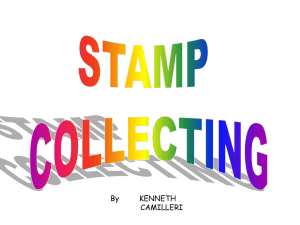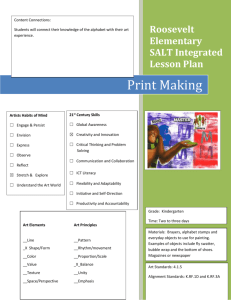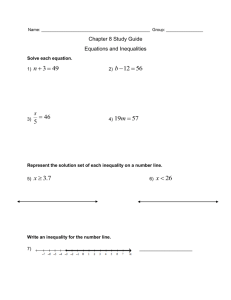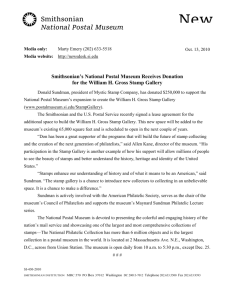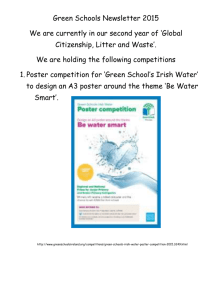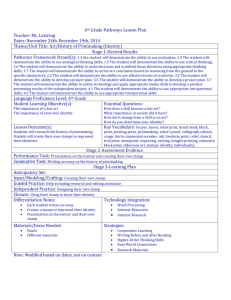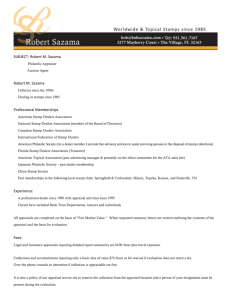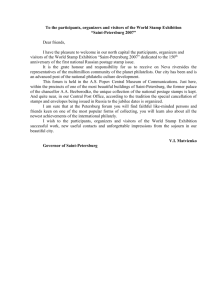Lighthouse02.doc - Eastbourne & South Downs Philatelic Society
advertisement
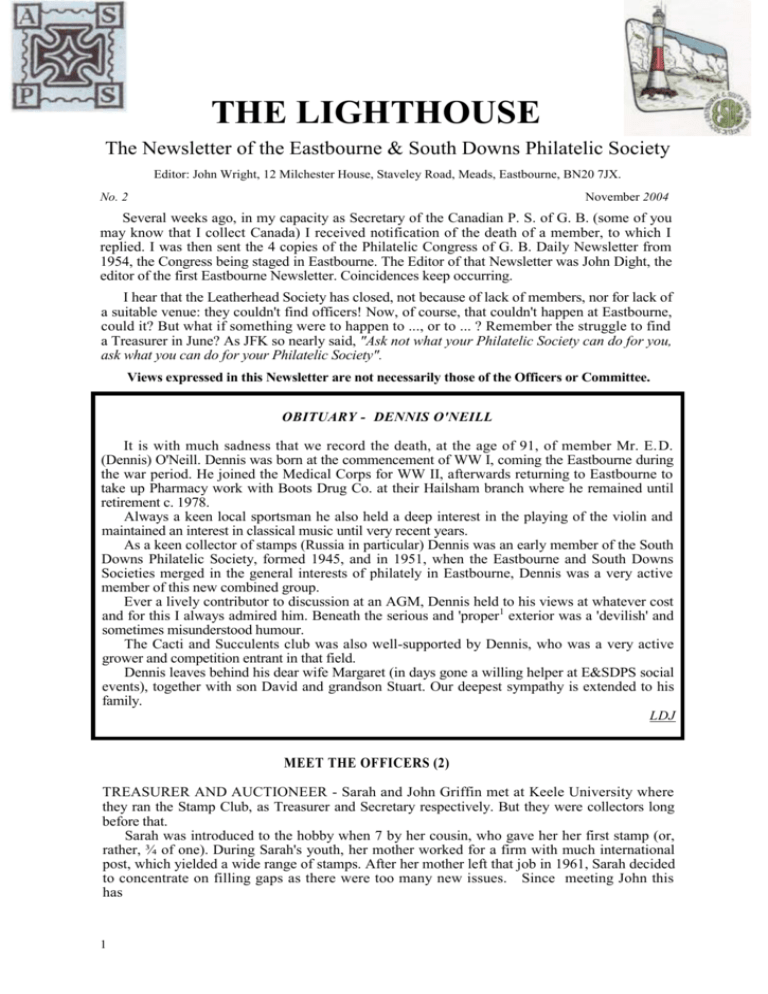
THE LIGHTHOUSE The Newsletter of the Eastbourne & South Downs Philatelic Society Editor: John Wright, 12 Milchester House, Staveley Road, Meads, Eastbourne, BN20 7JX. No. 2 November 2004 Several weeks ago, in my capacity as Secretary of the Canadian P. S. of G. B. (some of you may know that I collect Canada) I received notification of the death of a member, to which I replied. I was then sent the 4 copies of the Philatelic Congress of G. B. Daily Newsletter from 1954, the Congress being staged in Eastbourne. The Editor of that Newsletter was John Dight, the editor of the first Eastbourne Newsletter. Coincidences keep occurring. I hear that the Leatherhead Society has closed, not because of lack of members, nor for lack of a suitable venue: they couldn't find officers! Now, of course, that couldn't happen at Eastbourne, could it? But what if something were to happen to ..., or to ... ? Remember the struggle to find a Treasurer in June? As JFK so nearly said, "Ask not what your Philatelic Society can do for you, ask what you can do for your Philatelic Society". Views expressed in this Newsletter are not necessarily those of the Officers or Committee. OBITUARY - DENNIS O'NEILL It is with much sadness that we record the death, at the age of 91, of member Mr. E. D. (Dennis) O'Neill. Dennis was born at the commencement of WW I, coming the Eastbourne during the war period. He joined the Medical Corps for WW II, afterwards returning to Eastbourne to take up Pharmacy work with Boots Drug Co. at their Hailsham branch where he remained until retirement c. 1978. Always a keen local sportsman he also held a deep interest in the playing of the violin and maintained an interest in classical music until very recent years. As a keen collector of stamps (Russia in particular) Dennis was an early member of the South Downs Philatelic Society, formed 1945, and in 1951, when the Eastbourne and South Downs Societies merged in the general interests of philately in Eastbourne, Dennis was a very active member of this new combined group. Ever a lively contributor to discussion at an AGM, Dennis held to his views at whatever cost and for this I always admired him. Beneath the serious and 'proper1 exterior was a 'devilish' and sometimes misunderstood humour. The Cacti and Succulents club was also well-supported by Dennis, who was a very active grower and competition entrant in that field. Dennis leaves behind his dear wife Margaret (in days gone a willing helper at E&SDPS social events), together with son David and grandson Stuart. Our deepest sympathy is extended to his family. LDJ MEET THE OFFICERS (2) TREASURER AND AUCTIONEER - Sarah and John Griffin met at Keele University where they ran the Stamp Club, as Treasurer and Secretary respectively. But they were collectors long before that. Sarah was introduced to the hobby when 7 by her cousin, who gave her her first stamp (or, rather, ¾ of one). During Sarah's youth, her mother worked for a firm with much international post, which yielded a wide range of stamps. After her mother left that job in 1961, Sarah decided to concentrate on filling gaps as there were too many new issues. Since meeting John this has 1 changed with the addition of some thematic interests and a continuing Israel collection. She regards herself as a collector rather than a philatelist. It was a girl friend who introduced John to two hobbies. They were only 9 at the time, which limited the possibilities! The hobbies were Philately and Ornithology, and he has specialised in 'Birds on Stamps' ever since. His grammar school ran a successful stamp club and among those who have come through it are David Boyd (formerly of auctioneers Phillips), Brian Sole (British Thematic Association), and a newish member of Eastbourne. John also benefited from a good local stamp shop (for further background on this, see recent copies of Stamp Magazine). His first job was as a teacher at a school where the stamp club was run by Ian T. Hamilton, FRPSL, journalist and philatelic eccentric. A long-time member of the Bird Stamp Society, John has now given up exhibiting but in the past has entered a number of thematic competitions up to international level. Sarah and John joined the Society when they moved to the district in 1974 and have been keen supporters ever since. John has been on the committee continuously since about 1977, becoming involved with the Auctions in 1978. Sarah took over the Packet in 1984 and has now relinquished that role and is Treasurer for this year only! Members of other Societies over the years, they are both still members of the Civil Service PS (John was Packet Superintendent for about 15 years) and the British Thematic Association (John was the first Auctioneer). As far as the rest of their lives are concerned, Sarah was a scientist at the Royal Greenwich Observatory, based at Herstmonceux Castle until taking early retirement shortly after Helen was born. John left teaching becoming a Government Statistician and also took early retirement. Both consider stamps much more interesting. Editor's Note John & Sarah have supplied a number of small items, which it is hoped to use in future Newsletters. POTPOURRI CONGRATULATIONS to Betty and Frank Blincow who celebrated (in some style!) their Golden Wedding Anniversary on 28th August. AUTUMN STAMPEX 2004 brought Margery Wharton a Vermeil in the Literature Class for The Upland Goose, the Journal of the Falkland Islands Philatelic Study Group, and also the Frances Webb Memorial Trophy for the best Society Journal. THE A.S.P.S. CONVENTION saw Angela Reilly (Evolution of Postal Services) and Mike Clark (Beekeeping) winning Bronze Awards in the Thematics Class. Alright, so Angela was representing Battle, and Mike Heathfield, but they are Eastbourne Members. Frank Blincow and John Wright represented the Society in the Inter-Society Postal History and were placed 4th of 8. One really ought not to criticise the decision of the Referee, Umpire, or Judges, but with Frank's entry (Danzig - The Polish Corridor) one really has to ask if they knew what they were looking at. The New Auditor is Mike Farrant, Past President of A.S.P.S. and, twice, of Eastbourne. THE NEW members' rep on the Channel Islands S.S. Committee is our President Graham Little. THE CANADIAN Convention at Crawley saw Hugh Johnson winning the Stanley Godden Trophy for his Transatlantic Mail and John Wright winning the Lees-Jones Salver for Coil Stamps 1974-95 (it does help if there is only one entry!). NEW CATALOGUES in the Library include SG "Brunei, Malaysia and Singapore", large page size, c 100 pages, and SG "Part 21 Southeast Asia", 4th edition, c. 700 pages. SG "China" is about to appear. Contact John Griffin or Jeff Jewson Fleming if interested in the new SG C'wealth. The Editor seeks (appeals for, or begs for) information to make this a regular feature. Particularly significant Anniversaries (25m, 40th, 50th ...), or Birthdays (50,60, 70, 75,80,85 ....), the birth of a child or grandchild, successes in Competitions, or anything which you feel might be of more man personal interest, please let the Editor know. 2 GDINGEN - GDYNIA - GOTENHAFEN GDYNIA 1919 - 1945 WHAT'S IN A NAME ? bv FRANK BLINCOW At the Paris Peace Conference of 1919, the issue of assuring the reinstituted Poland "free and secure access to the sea" (as laid down in President Wilson's celebrated "Fourteen Points" was difficult to resolve. A special Commission appointed to consider the question concluded that Poland should be allowed to annex the ancient port of Danzig! Poland was seeking to re-establish her pre-1772 frontiers, with some modifications, and wanted a restored Polish Gdansk as her vital access to the sea. Lloyd George, the British Prime Minister, strongly objected to the Commission's report on the grounds that it did not take into account another of Wilson's Points, the principle of national self-determination. After much wrangling and argument a compromise was reached and by Articles of the Treaty of Versailles, the "Free City of Danzig" was created giving Poland equal access to the sea, this with the then largely German population. In 1920, Poland became embroiled in a war with Russia and Danzig dockworkers refused to unload French ammunition for Poland, the British occupation troops eventually undertaking the work. Conscious of her insecure dependence on Danzig, at enormous cost Poland transformed the former German fishing village of Gdingen into the modern port of Gdynia serving Poland through the relatively narrow strip of the "Polish Corridor" which isolated East Prussia from Germany. Added to other changes in the Treaty of Versailles affecting Germany, the Corridor became a somewhat hysterical propaganda item for the growing National Socialist Party (NAZIS) in Germany. When Germany invaded Poland on 1st September 1939, and Gdynia fell on 14th September, the Germans changed the name of the town to Gotenhafen (Goth's Harbour) on the basis that the Goths were an ancient tribe which had settled that part of the Baltic Coast. On 16th October 1939, the majority of Poles were expelled from Gotenhafen leaving only a small contingent of workers and the town reverted to West Prussia. All Polish names of streets, etc., were removed and "Germanised", notably the main square which was renamed "Adolf Hitler Platz". Postally, the Germans brought with them a Straight Line Canceller for "Postamt Gotenhafen", usually struck in green, and soon after typically German circular date stamps were available showing GOTENHAFEN/ date and time /letter 'a' etc. On 28th March 1945, after a long siege, Gotenhafen fell to the Red Army and was eventually returned to the New Republic of Poland and renamed Gdynia. Street and place names were replaced and a temporary "GDYNIA G / date" was used for a short time. Following the end of the Second World War, Gdynia became once again a main Baltic port for Poland. 3 REVIEW. . . . July 29th Two presentations opened the Meeting. The first, the Wren Cup (for services to the Society) to Sarah Griffin, the second, toe Egg Cup, very narrowly won by Frank Blincow with "Airmails around the Baltic, 1920 -1940". The scheduled part of the evening followed - King George VI by Graham Little (Egg Cup). A massive 270 sheets and many thousands of stamps of carefully chosen quality, practically all with cds cancels. Shades and perforation changes abounded with a smaller number of paper varieties. Nice to see Cyrenaica. Graham is trying to go deeply into Cyprus - not satisfied with the basic set, he is now trying for a set with Nicosia postmarks (and one with Famagusta, Larnaka, Limasol,....) and collecting the difficult Rural Post Offices used by very small villages where the Postmaster might be a farmer or even a monk! August 5th. Surface Printed G.B. by Bill Harrison (Egg Cup). Bill started with the 1847-54 Embossed, then moved on to his subject taking us from 1855 to the so-called "Jubilee" issue of 1887. Why so many watermarks (3 x garter, emblems, spray of rose, anchor, Imperial Crown)? Extra security was suggested although no members knew of forgeries (but does this mean the forgeries are very good?). Bill had a number of wing margin copies (some on cover or piece) which he dislikes, but not all agree with this! From many years collecting there were also a goodly number of the higher values, much admired. Jeff Jewson Fleming for his Egg Cup gave A Kew Gardens Tour, starting with a copy of the July 1823 Act which set up Kew Gardens, and a c.1720 "road" map of the area before the Gardens existed. The Heraldic Beast statues in front of the Palm House (25th Anniversary of the Coronation) were shown but he then improvised with stamps from many countries which showed flowers, fungi, butterflies, insects, wild animals, palms, birds, cats (which chase birds)(?), dogs (which chase cats)(??), etc. August 12th. German States and early Germany, Bill Hobbs (Egg Cup). Some 17 years ago, Bill joined our Society - when he saw the kind of standard which could be reached he was inspired to collect this material. With about 180 sheets, he started with a history of Thurn & Taxis, showed private posts of Berlin, Cologne, Chemnitz, Bochum, Essen, Hanover, Hamburg and Leipzig, and then States including Berlin, Brunswick, Hamburg, Oldenburg, Heligoland, Luebeck, Prussia, Saxony, and men North German Federation, Baden, Bavaria and Wurttenberg. Much excellent Postal Stationery including postcards. He finished with the first 3 sets of Germany and the Berlin Rohrpost (pneumatic post). August 19th. Canadian QE 11 by Roy Ferguson, Lewes. Vic Betteridge being in hospital, we were indebted to Roy for deputising at exceptionally short notice. Roy showed 250+ sheets of Canada from the last 50 years, his beautiful presentation drawing very favourable comments. Starting with the unpopular Karsh issue of 1953 he showed sheet and coil stamps, together with many of the booklets which proliferated in this period. The Centennial Definitives followed (so-called as their 1967 first appearance marked 100 years since Canadian Confederation in 1867) and explained the differences in Winnipeg and General tagging, both found in this period. With coil stamps Roy also showed the unusual coil blocks which may be found and brought us to the end of the century with the continuing Canadian Art series. August 26th Pastal Stationery of Italy and Switzerland, Vic Betteridge. An excellent display of Italy with some pretty, old, scarce items: Vic gave a short lecture on production methods, saying mat the two printers were very difficult to tell apart. Military cards were produced by each regiment, the plates travelling with the regiment and used whenever wanted. These were concessionary cards for the soldiers to use writing home at no cost. Italian cards of this period have illustration, stamp and address all on one side. The display included a number of postal order cards for transmission of money. Vic also showed some odd, very collectable Swiss cards, including one from a bridge match. There were lots of letter cards, a few PS envelopes, some airmail covers and some Charity cards (many of these being miniature works of art). September 2nd The Meeting opened with 1 minutes silence in memory of Dennis O'Neill. An appreciation by Lionel Jones, friend and philatelic colleague for some 45 years, appears on page 1. The display was by Brian Doherty, Storrington, who showed part of his excellent collection of British Levant, and who started by explaining that Levant was the eastern seaboard of the Mediterranean and that British Levant was the 5 British Post Offices in the former Turkish Empire. A military P.O. was established at Constantinople in the Crimean War, becoming civilian in 1857 with Smyrna (1872), Beyrout (1873), Stamboul (1884) and Salonika (1900) following. First used were ordinary GB stamps, the first surcharged (40 para = 1 piastre on 2½d) following in 1884 - these appeared because of the fluctuation in Turkish currency. A provisional 40 para on ½d, used for 5 days in 1887, has been extensively faked - perhaps 90% of the used copies are fakes and genuine mint (unless from UPU files) do not exist as the stamps were applied at the P.O. only on mail to GB. The Offices closed in WWI: an army P.O. opened in Constantinople in February 1919 reverting to civilian use in July 1920 and Smyrna reopened in 1919 using up old, unsurcharged stock. Brian showed the Pirie-Gordon confections of 1916, wanted by King George V, in addition to an impressive display of stamps, (particularly some wonderful Seahorses and earlier high values), covers, specimens and postal stationery. The last P.O. closed in 1923. Be very wary of fakes of the surcharged issues! September 9th Aspects of sending Money by Post, by Richard Solly, Beckenham. In the 18th century, notes were sometimes halved and posted in separate sendings - messy and unreliable. A private firm, with PMG's permission, started Money Orders in 1792. The purchased Money Order was sent to the payee, the other part being sent to the paying Office. Under Rowland Hill reforms the cost was reduced and an 1848 change required the Order to be presented within 12 months. The system became unprofitable and in 1881 Postal Orders were introduced in 10 denominations (1/- to 20/-). Further issues followed, and the 1903 King Edward had counterfoils and 41 denominations (6d - 21/-, no 20/6) allowing stamps to be added to make up the value required. Legal tender at the start of both World Wars. Offered to the Colonies in 1903, most accepting, but as poundage was charged by the UK to the Colonies a higher rate was charged by them. Australia and Canada each had her own system - each Australian State had its own postal note scheme from November 1880, and a common design (but still the State name) from 1912. A fascinating selection of overprinted material, particularly Irish, was shown. France had a very early Money Order system, and a Postal Order system for her Colonies to 1926. Sets of Postal Orders are very scarce although Specimens are more plentiful (and Richard had many). Very few cashed Postal Orders 4 exist and the condition of used material is often poor but because of the comparatively small number of collectors the scarcity of items is not reflected in the price, Septemberi 16th. Czech National Costume and Mucha, by Brian Day (Sittingboume). Alphons (or Alphonse) Mucha (1860 1939) was a, perhaps the, leading light in Art Nouveau style painting. He designed stamps for Czechoslovakia and also produced artwork for other countries which was not adopted. Cards featuring his designs, by France, Hungary and Bavaria, started in about 1899 and Brian showed some of these. Mucha travelled widely, spending much time in the United States, and as well as paintings and sculpture he designed banknotes and medallions. Brian showed a huge range of his work including cards which featured Mucha's decorations in the Municipal House, Prague. His designs have appeared on telephone cards and modern cards featuring reproductions of his work are on sale in England. A 1990 Czech stamp with his work was placed 2nd in a "best designed stamp" competition (the winning design was that for the 150th Anniversary of the Penny Black) and his work may be seen in the Mucha Museum in Prague. The second half featured cards with work by other Czech artists, many of which showed young women in National Costume. Particularly featured were Joza Uprka (1861 -1940), who painted local people in local dress (with headscarves very popular), folklore and customs; Josef Hercik (who designed many stamps for Czechoslovakia and other countries); and C. V. Munich. Some cards produced in the United States to recruit young men for the Czech army were shown, also some rare material from the Czech Field Post in Siberia and a card sent from Czechoslovakia to Algeria and written in Esperanto. October 7th Land's End and John o' Groats, by Steve Benz. Steve began by apologising to those who had hoped to see the advertised talk on The Hovercraft Story, but explained that a variety of reasons meant that this was not yet complete (we look forward to seeing this at a later date). During the first half he showed a selection of slides on Land's End, illustrating the development of the First and Last House, the various buildings, first and last signpost postbox and inn. Also shown were watercolours of the area published by Salmon's and Valentine's, humorous cards, Longship lighthouse and the famous rocks around the peninsula which do have names. During die second half, Steve showed his collection of Land's End tourist cachets on postcards: there are over 140 different cachets, be first appearing in 1901. The evening concluded with a display on John o' Groats - the development of the tiny settlement, the building of the hotel, last house and the nearby lighthouse. John o' Groats has fewer tourist cachets, with some very hard to come by and the early ones being mainly from the John o' Groats House Hotel. These ceased during the 1970s and today cachets are impressed by the First and Last House. Steve's collection has been formed over 25years and was inspired by a talk "Postmarks on Postcards" heard when he was a member of Crewe Philatelic Society in 1978 October 14th Malaya and States, Ken Santer (Egg Cup). Ken showed 18 frames from a collection developed over many years, including a frame of c. 1900 Singapore postcards. The Straits Settlements used stamps of India until 1867, when surcharged Indian stamps appeared, followed by Straits Settlements issues and Spiro forgeries of these. Many were surcharged locally, producing the to-be-expected varieties. New designs followed in 1892 and KE VII in 1902 (we also saw the specimen set of these). Labuan material was shown, the colony having been transferred to Straits administration in 1907. A wide range of KG V material followed, including stamps overprinted for the Malaya Borneo Exhibition of 1922 (we also saw mis overprint on Brunei, Kedah, Kelantan, North Borneo and Trengganu). Three covers from British Forces in Malaya were shown, one each passed by Army, Navy and RAF censor, and various Field Post Offices. There was also a good range of Japanese occupation. Free postage was allowed from September 17 1945 (when postal services resumed) until October 18 - two covers shown. The 'BMA Malaya' overprints were well-represented as was an interesting 'SNIGAPORE' postmark error found March 10 - April 17 1947 (and Ken had a strip of 5 of the lOc). Malaysia was formed in 1963 with Singapore leaving in 1965. In the interval, the Society welcomed MARK WALTERS, a new member. Ken's second half saw material f rom Johore*, Pahang*+, Kedah, Perlis, Sungei Ujong*, Negri Sembilan*+, Malacca, Perak*+, Penang, Selangor*+, Trengganu* and Kelantan (*indicates a state originally using overprints on Straits Settlements, + indicates part of the Federated Malay States 1900-35 so no specific stamps issued during that period). A small book needed to do justice to this display. .... and PREVIEW November 4th - Postcard Evening - Members November 7th - Hailsham Stamp Fair - Summerheath Hall, Summerheath Road, Hailsham (10 a.m. - 4 p.m.) November llth - Informal Evening and Auction Viewing November 18th - Auction November 20th & 21st - 5th ABPS National Stamp Exhibition, Towngate Theatre, Basildon (10 a.m. each day) November 25th - Safety at Sea - J. M. Czucman (Fleet, Hampshire) November 26th & 27th - THEMATICA - Carisbrooke Hall, 63 Seymour Street, London, W2 2HF December 2nd - Past Presidents Entertain December 3rd - East Sussex Postcard Club - Victorian Illumination - John & Thelma Burgess - A chance to see an original Magic Lantern Show. Together with Christmas Social. 5 December 9th - Christmas is Coming - Mike Clark - EGG CUP December 11th - Eastbourne Stamp Fair- St John Ambulance Brigade HQ, Bourne Street December 16th - CHRISTMAS PARTY - Members December 16th - Last day for receipt of material for January 6th Auction December 23rd - NO MEETING - Happy Christmas! December 30th - Informal Evening & Auction Viewing January 6lh - Auction January 7th - East Sussex Postcard Club - More Aspects of Lewes - Bob Caims returns after his visit in January 2004 to give an illustrated talk and to show further items from his amazing collection of postcards of Lewes & District. January 13th - (1) - Zanzibar- Michael Farrant FRPSL - EGG CUP (2) - Baltic States - Michael Wyatt January 20th - G, H, I stand for... - Members January 22nd - Eastbourne Stamp Fair- St. Mary's Church Hall, Decoy Drive (10 a.m. - 4 p.m.) (note change of venue) January 27th - The Road to Auschwitz - Ian Nutley (A postal history o the Holocaust) February 3rd - (1) - Postal History Competition - Members (2) - Video of Cyprus Stamps plus Question & Answer Forum February 3rd - Last day for receipt of material for February 24th Auction February 4th - East Sussex Postcard Club - Coasting along Sussex - a first visit from Geoffrey Mead, Sussex University lecturer, illustrating with old postcards the coastline from Selsey to Rye. VERY IMPORTANT DIARY DATE SATURDAY 22nd APRIL 2006 - A. S. P. S. CONVENTION, TO BE HOSTED JOINTLY BY EASTBOURNE & SOUTH DOWNS P. S. and the EAST SUSSEX POSTCARD CLUB. at WILLINGDON COMMUNITY COLLEGE PHILATELIC. TALE Arthur and Hugh were well into their eighties and had been friends for over sixty years. In fact, each had been Best Man at the other's wedding. Their life-long passion was philately. One day, Arthur began to wonder aloud if there was a Philatelic Society in heaven. Both had been solid citizens and had no doubt that was where they would end up. Being such good friends, and nearly always seeing eye-to-eye, Hugh said he would devise a plan to find out. It was agreed that, whichever got to heaven first would, in some way, let the other know the answer. Sadly, within a year of their plan, Hugh died quite suddenly while reading the latest 'Gibbons' red book. A good month passed before Hugh made his agreed appearance: it was in the middle of the night and even though Arthur had consumed a large supper, and several glasses of best port, there was no mistaking that it was Hugh come back. Hugh spoke just as he had done in life: "Great news, Arthur, there is a St. Peter's Philatelic Society. However, I've got some bad news for you - you're next month's speaker". j&sg 6
